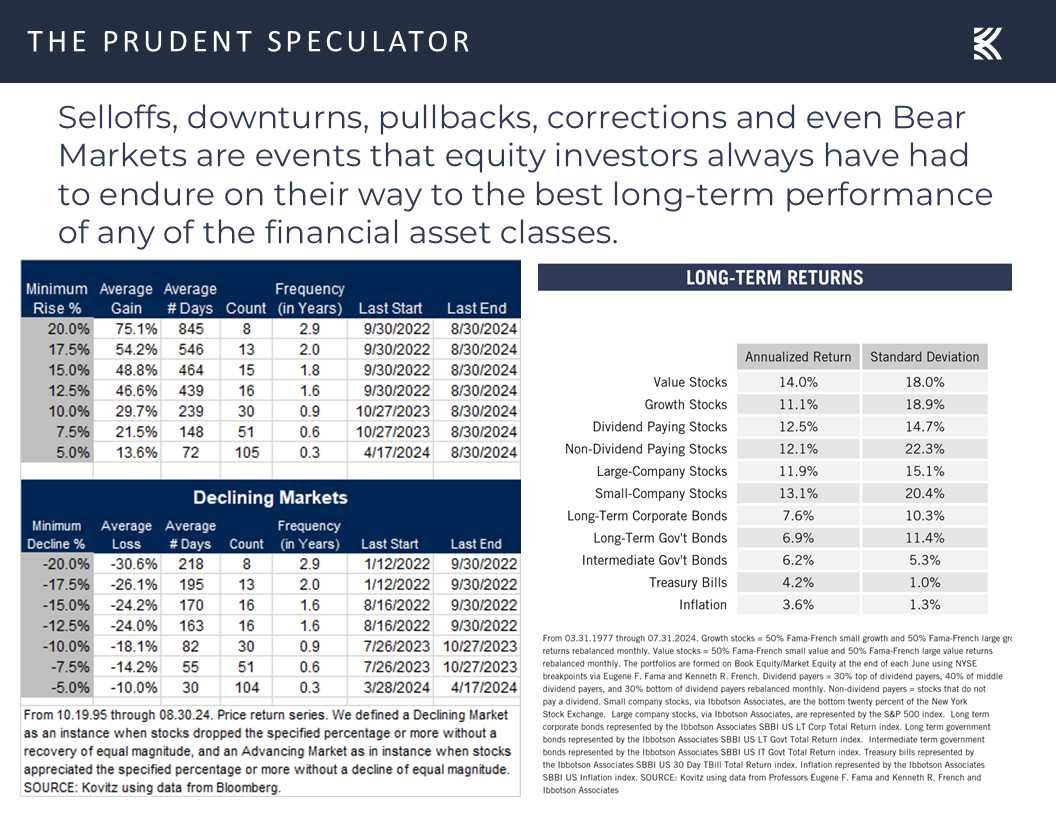The historically turbulent September Scaries for stocks (the September to October period) have once again introduced a familiar dose of market volatility for investors
The historically turbulent September Scaries (the September to October period) have once again introduced a familiar dose of market volatility for equity investors. This year, the season kicked off on a sour note, with the Russell 3000 index experiencing a decline of 5.2%, while the S&P 500 posted its worst weekly performance since March 2023, dropping by more than 4.2%. Though unsettling to some, seasoned investors understand that these fluctuations are not out of the ordinary.
Going back to 1928, the S&P 500 has experienced 203 weeks with even larger setbacks. It’s worth remembering that a 5% market downturn occurs, on average, three times a year, while 7.5% corrections take place roughly every seven months. Furthermore, 10% corrections typically happen almost once a year. These statistics should remind investors that market corrections are a natural and expected part of stock market cycles.
Volatility: A Natural Part of Market Cycles
It’s important for investors to recognize that volatility is a normal characteristic of the stock market. While seeing portfolio values drop can be uncomfortable, putting these fluctuations into perspective helps to maintain a long-term outlook. Last week’s S&P 500 drop of over 4.24% is far from unprecedented, as the market has endured similar or worse declines numerous times. Moreover, there have been 169 weeks with gains of similar magnitude, highlighting the ups and downs that characterize market performance.

September Scaries: The Narrative Quickly Shifts
One interesting aspect of market psychology is the speed at which investor sentiment can shift. In early September, headlines celebrated the optimism of U.S. investors, with phrases like, “U.S. investors have rarely been this giddy about the stock market,” and “The American consumer is starting to shake out of a lingering bad mood.”
However, this enthusiasm quickly faded after a weaker-than-expected August jobs report, which showed the economy added only 142,000 jobs. This led to renewed fears about the state of the U.S. economy, prompting headlines about steep market losses and economic uncertainty. The sudden shift in tone illustrates how rapidly market sentiment can flip, even when economic fundamentals remain relatively unchanged.
Long-Term Optimism Amid Short-Term Pullbacks (like the September Scaries)
Despite the short-term pessimism caused by negative headlines and market pullbacks, there are still reasons to be optimistic. The fundamentals of the market have not shifted drastically, and for investors who can maintain a disciplined, long-term approach, the current volatility presents potential buying opportunities.
Undervalued stocks offer promising long-term prospects, and while market downturns can be uncomfortable, they often pave the way for future gains. Those with the patience to endure short-term setbacks will likely be rewarded in the years to come.

Don’t Let the September Scaries Scare You
In conclusion, while the September-October market volatility may seem alarming, seasoned investors know that it is a normal part of the investment cycle. The focus should remain on the long-term potential of undervalued stocks, as those willing to weather the storm are often handsomely rewarded. This post also appeared on Forbes. For a full library of our content, please visit our Blog.
Kovitz Investment Group Partners, LLC (“Kovitz”) is an investment adviser registered with the Securities and Exchange Commission. This report should only be considered as a tool in any investment decision and should not be used by itself to make investment decisions. Opinions expressed are only our current opinions or our opinions on the posting date. Any graphs, data, or information in this publication are considered reliably sourced, but no representation is made that it is accurate or complete and should not be relied upon as such. This information is subject to change without notice at any time, based on market and other conditions. Past performance is not indicative of future results, which may vary.



